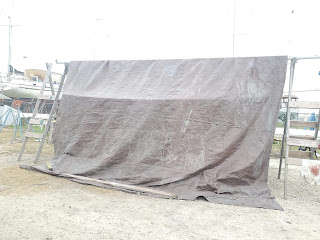Painting prep part 2: sanding the deck

Now that the weather is nicer & more suitable for restoring old sailboats, I returned to making a lot of dust by sanding Cantara's deck clean of all old non-skid and paint in preparation for a new boat paint job. One of the curious discoveries after sanding away the old deck paint were the aluminum plates under the stern cleats. Not sure who put them there or why; they were only lightly glassed-over so I am guessing they were not meant as backing plates to the cleats but were top plates instead? Are they original to the design? The pink filler matches that around the rest of the stern deck suggesting these were original to the boat. Cape Dory famously used mild steel backing plates for chainplates but flush aluminium top plates for stern cleats? Doesn't make sense. Anyway the whole stern deck is going to have to come off along with these plates due to extenive moisture damage around the deckplate holes, which extends all the way down to the cockpit seats too. Sanding the or






.jpeg)